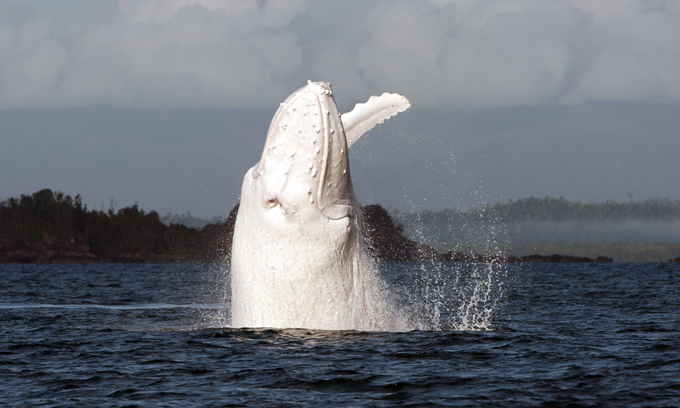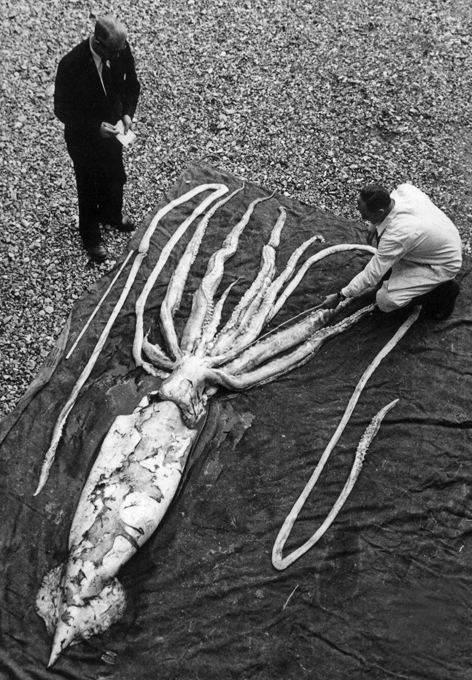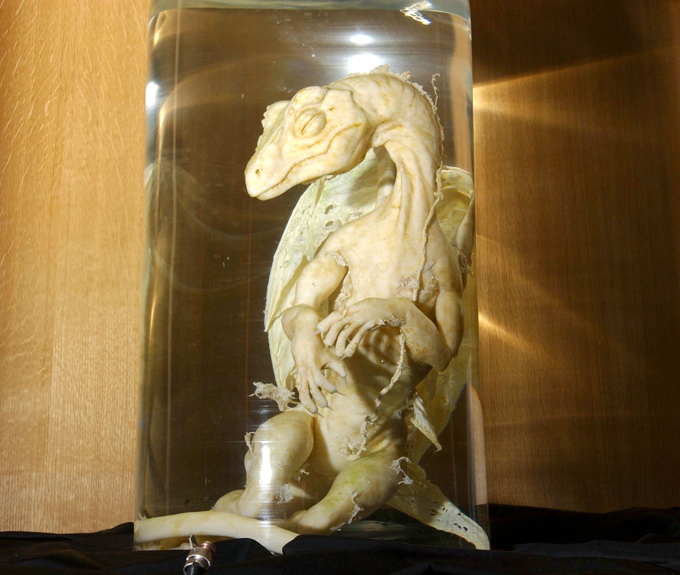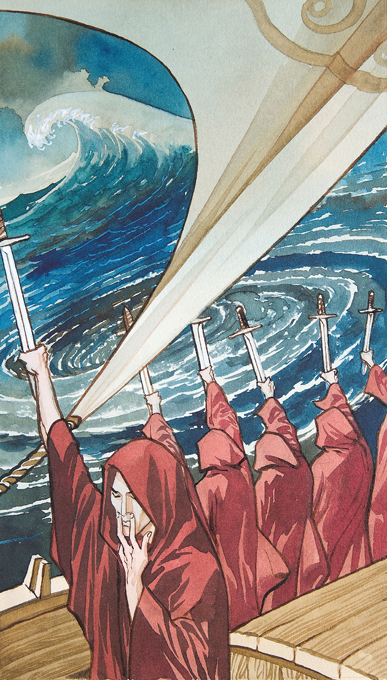Fairytale creatures in real life

The sperm whale, or cachalot, is the largest of the toothed whales and the largest toothed predator. It is the only living member of genus Physeter, and one of three extant species in the sperm whale family. The sperm whale can be found anywhere in the open ocean. Females and young males live together in groups while mature males live solitary lives outside of the mating season. The females cooperate to protect and nurse their young
The sperm whale, or cachalot, is the largest of the toothed whales and the largest toothed predator. It is the only living member of genus Physeter, and one of three extant species in the sperm whale family. The sperm whale can be found anywhere in the open ocean. Females and young males live together in groups while mature males live solitary lives outside of the mating season. The females cooperate to protect and nurse their young

The giant squid is a deep-ocean dwelling squid in the family Architeuthidae. Giant squid can grow to a tremendous size due to deep-sea gigantism: recent estimates put the maximum size at 13 m (43 ft) for females and 10 m (33 ft) for males from the posterior fins to the tip of the two long tentacles (second only to the colossal squid at an estimated 14 m (46 ft), one of the largest living organisms). The mantle is about 2 m (6.6 ft) long (more for females, less for males), and the length of the squid excluding its tentacles (but including head and arms) rarely exceeds 5 m (16 ft). Claims of specimens measuring 20 m (66 ft) or more have not been scientifically documented
The giant squid is a deep-ocean dwelling squid in the family Architeuthidae. Giant squid can grow to a tremendous size due to deep-sea gigantism: recent estimates put the maximum size at 13 m (43 ft) for females and 10 m (33 ft) for males from the posterior fins to the tip of the two long tentacles (second only to the colossal squid at an estimated 14 m (46 ft), one of the largest living organisms). The mantle is about 2 m (6.6 ft) long (more for females, less for males), and the length of the squid excluding its tentacles (but including head and arms) rarely exceeds 5 m (16 ft). Claims of specimens measuring 20 m (66 ft) or more have not been scientifically documented

В 2004 году останки хоббитов были обнаружены в Индонезии на острове Флорес. Так назвали карликовых гоминидов, которые, по мнению некоторых ученых, являются прямыми потомками человека прямоходящего - Homo erectus.
Читайте:
Толкиену и не снилось: хоббиты и гномы могли жить в древности
В 2004 году останки хоббитов были обнаружены в Индонезии на острове Флорес. Так назвали карликовых гоминидов, которые, по мнению некоторых ученых, являются прямыми потомками человека прямоходящего - Homo erectus.
Читайте:
Толкиену и не снилось: хоббиты и гномы могли жить в древности

The dire wolf (Canis dirus, "fearsome dog") is an extinct species of the genus Canis. It is perhaps one of the most famous prehistoric carnivores in North America along with its extinct competitor Smilodon, the "saber-toothed cat". The dire wolf lived in the Americas during the Late Pleistocene epoch (125,000-10,000 years ago). The species was named in 1858, four years after the first specimen had been found. Two subspecies are recognized, these being Canis dirus guildayi and Canis dirus dirus. The species probably descended from Canis ambrusteri and evolved from it in North America. The largest collection of dire wolf fossils has been obtained from the Rancho La Brea Tar Pits in Los Angeles, California
The dire wolf (Canis dirus, "fearsome dog") is an extinct species of the genus Canis. It is perhaps one of the most famous prehistoric carnivores in North America along with its extinct competitor Smilodon, the "saber-toothed cat". The dire wolf lived in the Americas during the Late Pleistocene epoch (125,000-10,000 years ago). The species was named in 1858, four years after the first specimen had been found. Two subspecies are recognized, these being Canis dirus guildayi and Canis dirus dirus. The species probably descended from Canis ambrusteri and evolved from it in North America. The largest collection of dire wolf fossils has been obtained from the Rancho La Brea Tar Pits in Los Angeles, California

In Greek mythology, the Amazons were a race of women warriors. Scythian women were the real-world basis for the myth. Herodotus reported that they were related to the Scythians (an Iranian people) and placed them in a region bordering Scythia in Sarmatia (modern territory of Ukraine). Other historiographers place them in Anatolia,or sometimes Libya
In Greek mythology, the Amazons were a race of women warriors. Scythian women were the real-world basis for the myth. Herodotus reported that they were related to the Scythians (an Iranian people) and placed them in a region bordering Scythia in Sarmatia (modern territory of Ukraine). Other historiographers place them in Anatolia,or sometimes Libya

European dragons are usually depicted as malevolent under Christianity; pre-Christian dragons, such as Y Ddraig Goch, the Red Dragon of Wales, are seen as benevolent. Banners of the Late Roman Empire frequently figured Dragons, possibly due to the fact that Marcus Aurelius took over 8,000 Sarmatian soldiers into the Roman army, for whom the Dragon was a part of their military insignia
European dragons are usually depicted as malevolent under Christianity; pre-Christian dragons, such as Y Ddraig Goch, the Red Dragon of Wales, are seen as benevolent. Banners of the Late Roman Empire frequently figured Dragons, possibly due to the fact that Marcus Aurelius took over 8,000 Sarmatian soldiers into the Roman army, for whom the Dragon was a part of their military insignia

In Greek mythology, Scylla was a monster that lived on one side of a narrow channel of water, opposite her counterpart Charybdis. The two sides of the strait were within an arrow's range of each other-so close that sailors attempting to avoid Charybdis would pass too close to Scylla and vice versa. Scylla made her first appearance in Homer's Odyssey, where Odysseus and his crew encounter her and Charybdis on their travels. Later myth gave her an origin story as a beautiful nymph who gets turned into a monster.
In Greek mythology, Scylla was a monster that lived on one side of a narrow channel of water, opposite her counterpart Charybdis. The two sides of the strait were within an arrow's range of each other-so close that sailors attempting to avoid Charybdis would pass too close to Scylla and vice versa. Scylla made her first appearance in Homer's Odyssey, where Odysseus and his crew encounter her and Charybdis on their travels. Later myth gave her an origin story as a beautiful nymph who gets turned into a monster.

Berserkers (or berserks) were champion Norse warriors who are primarily reported in Icelandic literature to have fought in a trance-like fury, a characteristic which later gave rise to the English word berserk. These champions would often go into battle without mail-coats; the word "berserk" meant going into battle wearing only bear pelts or other animal skins
Berserkers (or berserks) were champion Norse warriors who are primarily reported in Icelandic literature to have fought in a trance-like fury, a characteristic which later gave rise to the English word berserk. These champions would often go into battle without mail-coats; the word "berserk" meant going into battle wearing only bear pelts or other animal skins



